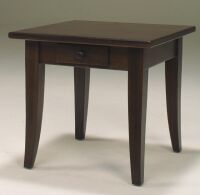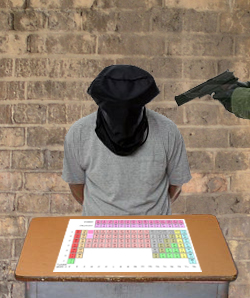Periodic table

The Periodic Table, not to be confused with the Occasional Table, is a tabulated list of all known chemical elements constructed by chemists, purely to serve as a challenge to see who has the best recall memory. It was created in response to criticisms scientists received for not having a string of pointless data for bored nerds to spend their time studying to compete with the ever-fascinating competition between mathematicians for who can recite pi to the greatest number of decimal places.
The table currently stands at 118 entries, or 120, or 122, depending on which high-energy particle accelerator you ask. However many elements you are prepared to accept exist, the number seems a little bit weak in comparison to the infinite entries of pi, a source of endless shame to chemists everywhere. However, since the elements are arranged in order of atomic number rather than mass, and jump all over the alphabet, the challenge is not straight forward. Many entries also have similarly spelled names to others, inducing much confusion. Many have been humiliated in memory recall challenges by confusing thulium and thallium. And there is no surer way to start a fight at the Anglo-American Inorganic Chemistry Christmas party than to initiate a debate on the correct spelling of Sulphur/Sulfur. {Hint: until we accept Fosforus as a correct alternative to Phosphorus, there is no need for debate}?
Memorizing the periodic table[edit]
One method of memorizing the periodic table involves first taking all the elements' atomic symbols and arranging them in order based on atomic number. Next, simply create a mnemonic with each word containing an atomic symbol (For example, hydrogen's atomic symbol is H, so the first word in the mnemonic could be Harold). A classic example of this method containing all 118 elements is provided below:
Harry,
He
Likes
Beryllium, Boron, Carbon, Nitrogen, Oxygen, Fluorine, Neon, Sodium (Na), Magnesium, Aluminum, Silicon, Phosphorus, Sulfur, Chlorine, Argon, Potassium (K), Calcium, Scandium, Titanium, Vanadium, Chromium, Manganese, Iron (Fe), Cobalt, Nickel, Copper (Cu), Zinc, Gallium, Germanium, Arsenic, Selenium, Bromine, Krypton, Rubidium, Strontium, Yttrium, Zirconium, Niobium, Molybdenum, Technetium, Ruthenium, Rhodium, Palladium, Silver (Ag), Cadmium, Indium, Tin (Sn), Antimony (Sb), Tellurium, Iodine, Xenon, Cesium, Barium, Lanthanum, Cerium, Praseodymium, Neodymium, Promethium, Samarium, Europium, Gadolinium, Terbium, Dysprosium, Holmium, Erbium, Thulium, Ytterbium, Lutetium, Hafnium, Tantalum, Tungsten (W), Rhenium, Osmium, Iridium, Platinum, Gold (Au), Mercury (Hg), Thallium, Lead (Pb), Bismuth, Polonium, Astatine, Radon, Francium, Radium, Actinium, Thorium, Protactinium, Uranium, Neptunium, Plutonium, Americium, Curium, Berkelium, Californium, Einsteinium, Fermium, Mendelevium, Nobelium, Lawrencium, Rutherfordium, Dubnium, Seaborgium, Bohrium, Hassium, Meitnerium, Darmstadtium, Roentgenium, Copernicium, Nihonium, Flerovium, Moscovium, Livermorium, Tennessine and Oganesson
Recite this phrase a few times, and you'll find yourself learning the periodic table in no time.
| H | | He | |||||||||||||||
| Li | Be | | B | C | N | O | F | Ne | |||||||||
| Na | Mg | | Al | Si | P | S | Cl | Ar | |||||||||
| K | Ca | Sc | Ti | V | Cr | Mn | Fe | Co | Ni | Cu | Zn | Ga | Ge | As | Se | Br | Kr |
| Rb | Sr | Y | Zr | Nb | Mo | Tc | Ru | Rh | Pd | Ag | Cd | In | Sn | Sb | Te | I | Xe |
| Cs | Ba | Lu | Hf | Ta | W | Re | Os | Ir | Pt | Au | Hg | Tl | Pb | Bi | Po | At | Rn |
| Fr | Ra | Lr | Rf | Db | Sg | Bh | Hs | Mt | Ds | Rg | Cn | Nh | Fl | Mc | Lm | Ts | Og |
| | |||||||||||||||||
| La | Ce | Pr | Nd | Pm | Sm | Eu | Gd | Tb | Dy | Ho | Er | Tm | Yb | ||||
| Ac | Th | Pa | U | Np | Pu | Am | Cm | Bk | Cf | Es | Fm | Md | No | ||||
